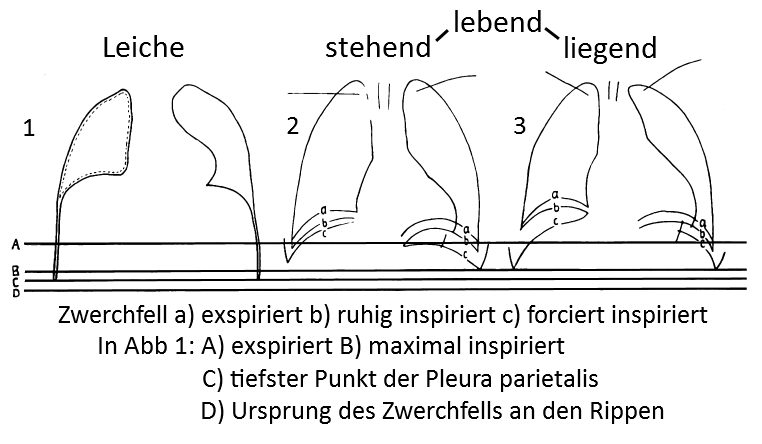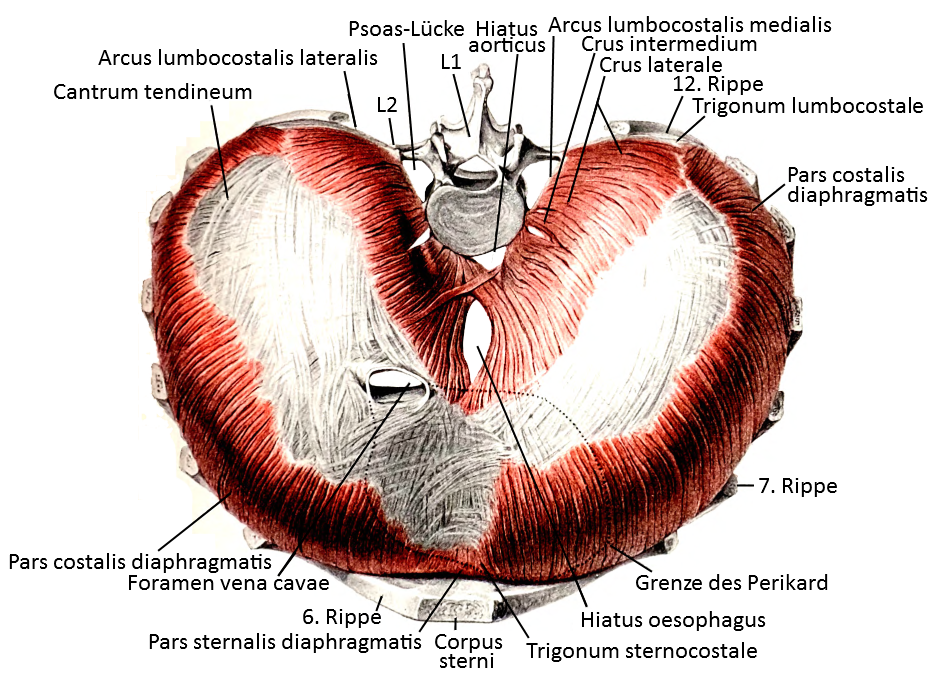
Contents
Diaphragm
The 3-5 mm thick diaphragm is the muscle/tendon plate that separates the abdominal cavity from the chest cavity and causes an enlargement of the chest cavity and thus abdominal breathing through contraction. Due to the retraction forces of the lungs (contraction in the direction of the expired state), the diaphragm has an upwardly convex dome shape in the expired state. The shape of the diaphragm changes to conical during contraction, with the muscles contracting by 30-34%. The activity of the diaphragm accounts for 60-80% of the muscular action at rest. The diaphragm is covered by the pleura on the thoracic side and by the peritoneum on the abdominal side. The diaphragm has three points of passage:
- the aortic slit for the aorta and the thoracic duct
- the esophageal slit for the esophagus and the two main trunks of the vagus nerve
- Hollow vein hole for the v. cava inf. with a fixed fascial ring to prevent the vein from collapsing
Smaller openings exist for the v. azygos, the n. splanchnicus, the symphatic trunk, the Larrey fissure and the Morgagni hole, through which the v. epigastrica passes. The Bochdalek gap between the loins and the rib section forms a weak point in the diaphragm through which pus is most likely to break through or hernias occur in the event of infection. The aortic and esophageal slits are also only weakly fascially secured and represent weak points. The lungs and mediastinum are located supradiaphragmal and the liver subdiaphragmal. The contraction of the peritoneum exerts pressure on the abdominal organs, but as the abdominal muscles are usually released during inspiration, this does not necessarily lead to an increase in pressure in the abdominal cavity. In combination with contracted abdominal muscles, however, an increase in pressure (abdominal pressure) can be caused, e.g. during a bowel movement or contractions. During diaphragmatic contraction, the diaphragm of the oesophagus is contracted, thus narrowing the oesophagus. The diaphragm also performs another function by increasing the pressure on the vena cava inf. during venous blood transport. The diaphragm can be trained like any other muscle, which is particularly relevant for runners over medium distances. Training takes place against external pressure (in water), among other things. Singultus (hiccups) is a normally harmless clonic spasm of the diaphragm. Side stitches are considered to be hypoxia of the diaphragm with consecutive spasms.
Origin:
- Lumbar section with two legs (left and right) that attaches to the ventral side of the lumbar spine
- Rib section that extends dorsally to the last rib and from there rises forward along the costal arches to the 7th rib.
- Part of the sternum that attaches to the processus xiphoideus.
Insertion:
Innervation: Nervus phrenicus from Plexus cervicalis (C3 to C5)
Diaphragm after breathing activity

Diaphragm in lateral position

Bezeichungen wie oben.
Diaphragm

